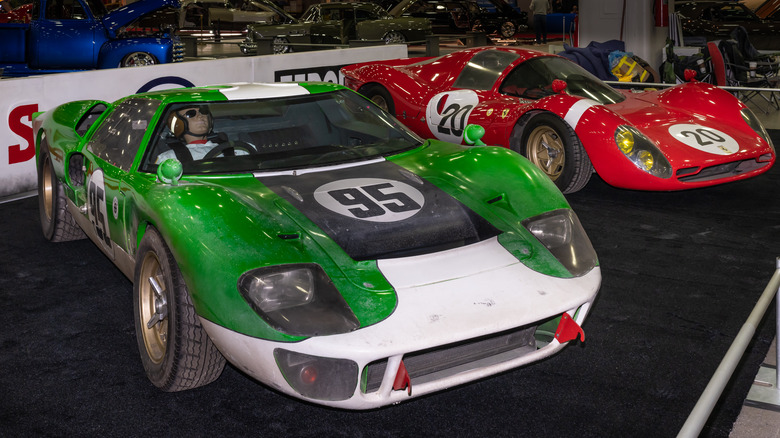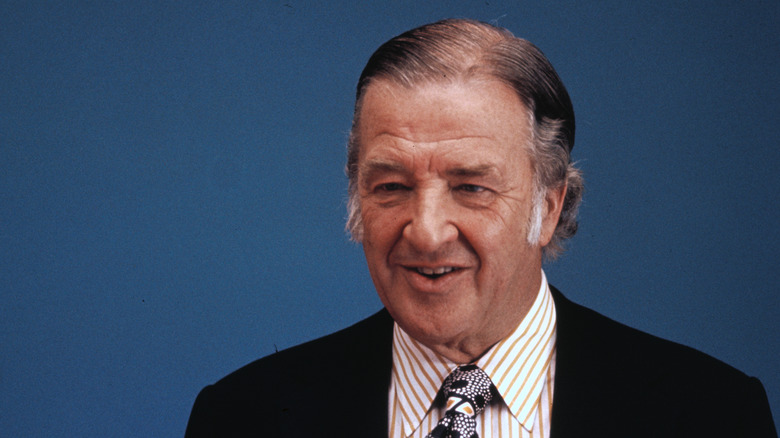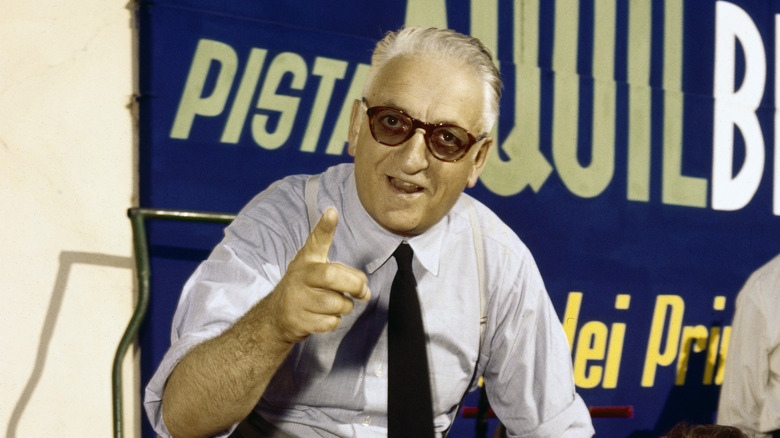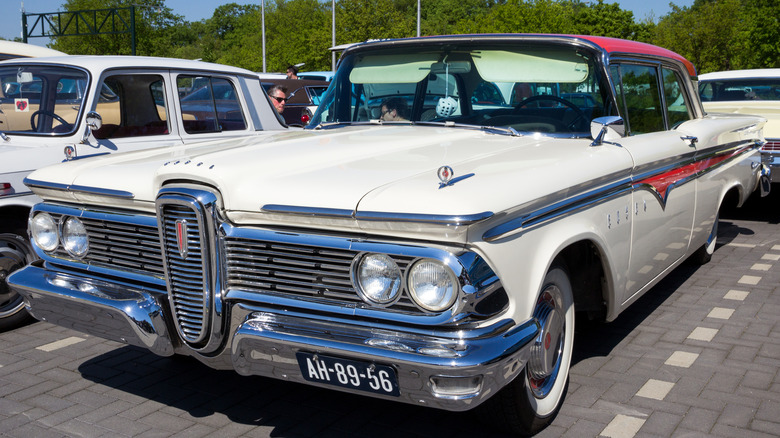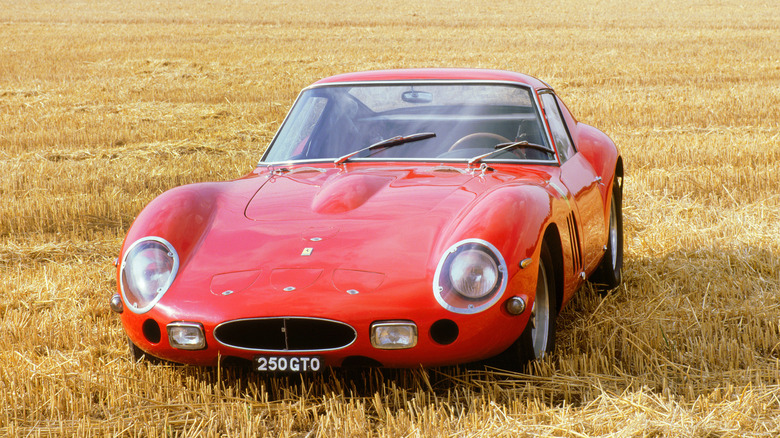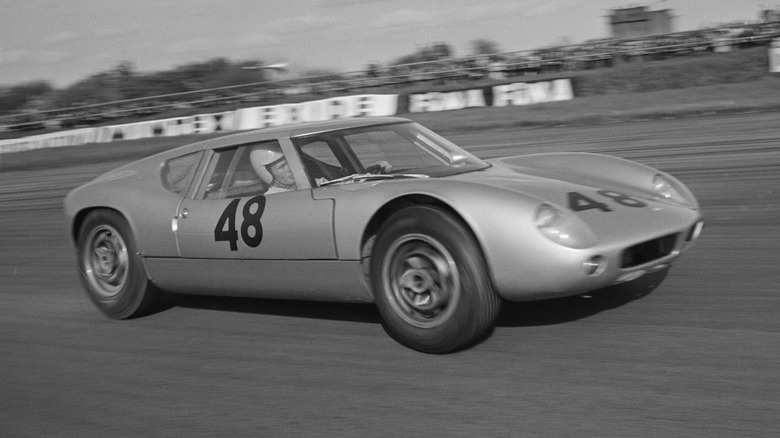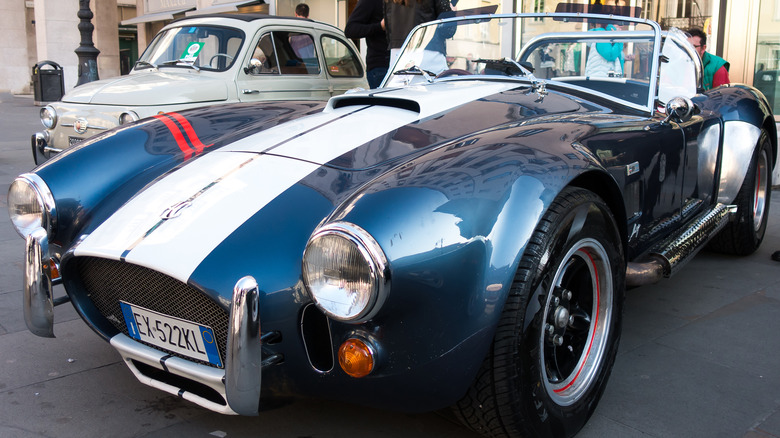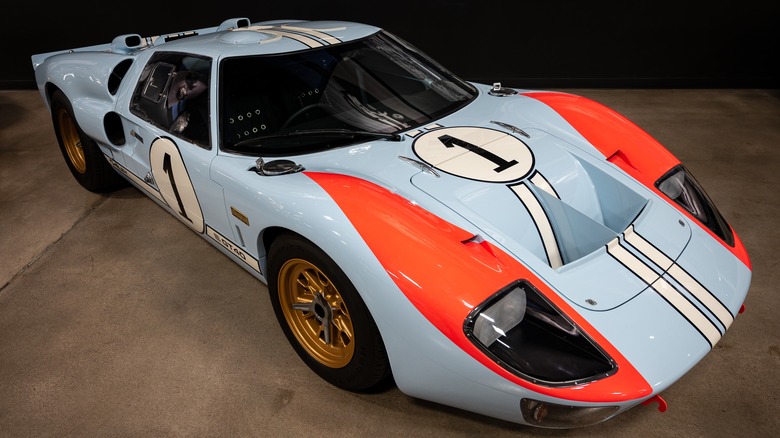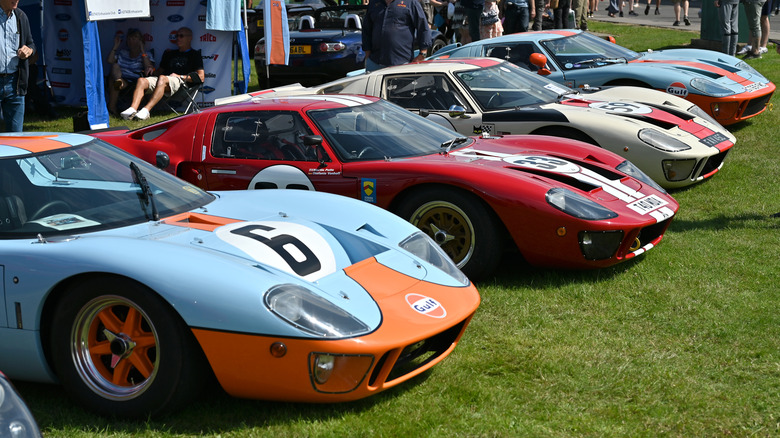Ford Vs. Ferrari: The History Behind One Of Motorsports Greatest Triumphs
"Ford v. Ferrari" premiered in 2019, introducing the wider culture to a little-known rivalry that changed the course of racing. It details the conflict between Enzo Ferrari, the founder of Ferrari, and Ford Motor Company Chairman and CEO Henry Ford II, grandson of Henry Ford.
The film tells the story of how racing mechanic Carroll Shelby (Matt Damon) and British driver Ken Miles (Christian Bale) took on Ferrari at one of the most grueling races out there: the historic 24 Hours of Le Mans. It's engaging and fun, and despite being focused on a niche subject aimed at auto and racing fans, it caught the attention of moviegoers, ultimately grossing $225 million against a $98 million budget.
Industry titans Ferrari and Ford II were once on the cusp of establishing an automotive partnership. However, when the deal went south, Ford swore to deliver a blow to Ferrari in the place that would hurt the prickly Italian the most: the racetrack. The rivalry born of bruised egos and enormous resources would deliver one of the most revered cars in the annals of racing history – the Ford GT40.
The movie does a great job of highlighting how the GT40 came to be and offers plenty of eye candy for fans of racing and sleek mid-1960s cars. Still, how did Ford (a company with virtually no sports pedigree whatsoever) defeat Ferrari (which was essentially a race team with an attached manufacturing division) at what it did best?
The tale is one of ego and hubris, enormous resources, and roaring engines. Join us as we examine the history behind one of motorsport's greatest triumphs.
Henry Ford II
Edsel Ford served as company president beginning in 1919. Popular and competent, Edsel kept a steady hand on the Ford company for decades. Edsel named his son, Henry Ford II after his own legendary father. It was always expected that Henry Ford II would enter the family business, but after Edsel's premature death from cancer in 1943, the timeline sped up. The original Henry Ford ran the company again for a couple of years, but Henry Ford II took over the role of President upon his grandfather's death in 1945.
As president and later CEO, Henry Ford II had a hill to climb. Ford was in organizational and financial disarray, on the verge of bankruptcy, and suffering under the leadership of poor senior management. He brought in 10 veterans of the United States Army Air Force officer corps (including future Secretary of State Robert McNamara), known as the Whiz Kids, to restructure operations and untangle shoddy financial practices.
His efforts worked. The Ford Motor Company bounced back, launching one of the most iconic cars of the 1950s with the Ford Thunderbird. Ford II is often credited today with being the savior of Ford. However, it didn't stay all sunshine and peaches as the late 1950s saw the introduction of the Ford Edsel — a vehicle so egregiously flawed it became synonymous with failure, inciting Ford II to make a move to save the company. That's when he met Enzo Ferrari.
Enzo Ferrari
Unlike Henry Ford II, who was born into a family that developed cars for the masses, Enzo Ferrari lived on the race track. An Alfa Romeo racing driver from 1920, the irascible Ferrari founded Scuderia Ferrari in 1929 to work in tandem with Alfa Romeo, preparing them for the track. By 1931, he was out of the cockpit and into the office, retiring from driving and taking up management. In 1937, the relationship between Ferrari and Alfa Romeo soured. Alfa bought out Scuderia Ferrari, and in 1939, Ferrari broke off relations.
The Italian government forced Ferrari to develop war material during the World War II, but he never lost his passion for racing. His first completely self-designed and built car, the Ferrari 125 S, hit the track in 1947, earning Ferrari a Grand Prix win in May of that year. Ferrari the man and Ferrari the company underwent several challenges in the late 1950s. Coupled with his 24-year-old son dying from muscular dystrophy in 1956, Ferrari was charged with and ultimately acquitted of manslaughter when a crash killed a navigator and nine spectators at the Mille Miglia in 1957.
To continue funding his passion for racing, he developed road-going cars. The Ferrari name represented premium performance on the racetrack and the street. Royals, celebrities, and the wealthy have been buying Ferraris for the past several decades as symbols of their elite status.
The Edsel disaster
It was 1957. Henry Ford II had been running Ford for nearly a decade, and he had a big plan under his hat. For 10 years, an entire division of the Ford Motor Company had spent $250 million developing a brand-new line aimed at capturing the medium-priced market. The Edsel, named after Ford II's father, was expected to sell up to 400,000 units annually. Buzz was high for the secret Edsel thanks to a Ford marketing blitz and their refusal to show the car to anyone before its release.
To say that the Edsel's debut on September 4, 1957, was a flop would be like calling the Hindenburg a deflated balloon. With consumers expecting cars that shattered all convention, the Edsel seemed little more than a typical Ford — and an ugly one at that. Ford promptly shot itself in the other foot by shipping several incomplete or incorrectly built cars, fostering rumors of poor quality. It didn't take long for the Edsel disaster to become a massive flop for Ford. The entire line was discontinued after only two production years.
A broken deal
The spectacular flameout of the Edsel represented a coming sea change. Young people born in the baby boom following World War II were coming of age. There were millions of them; they had resources, and they wanted fast cars. Without a single sports car in its lineup, Ford had nothing to offer one of the largest consumer demographics in economic history. Developing a sports car from scratch would take years and cost millions.
Desperate to get into the performance game, Ford II and Ford Vice President Lee Iacocca devised a plan — buy Ferrari, thus adding a stable of exclusive and powerful racers to the portfolio in one fell swoop. Several secret meetings between the companies took place in 1963. Ford employees inspected Ferrari's bespoke auto production facilities, ultimately coming up with an offer of $10 million (around $100 million today). Enzo Ferrari seemed amenable, but there was a dealbreaker.
After months of negotiation, the contract included a clause specifying that Ford would dictate the Ferrari racing budget. Ferrari torpedoed the deal, swearing he would never make a deal with those terms. According to Forbes, he highlighted his position by calling Ford an "ugly company that builds ugly cars in an ugly factory." He also may have gone so far as to imply Henry Ford II was nothing compared to his grandfather.
Ford II was powerful, and Ferrari's words damaged his ego. He wanted revenge. He decided he would get it by beating Enzo where it would hurt the ultra-competitive man the worst: the racetracks of Europe.
Ferrari killer and the Advanced Vehicles Group
Stung by Ferrari's insulting rejection, Henry Ford II resolved to beat Enzo Ferrari at his own game. He ordered the creation of the Advanced Vehicles Group (AVG). Their mission? Build a car to beat Ferrari at Europe's most brutal endurance race: the 24 Hours of Le Mans. He tapped Engineer Roy Lunn, a British expat who had worked with Aston Martin and on the recently developed Mustang concept, to develop the race car. Lunn presented Ford with a mid-engine, two-seater concept with a height of 40 inches. It took Ford five minutes to approve the design that would become the GT40
Lunn soon bought a pair of Lola GTs — midship custom race cars with an aluminum frame and Ford V8 powerplant — and managed to amass a $1.7 million budget for the project. Applying his knowledge and the Ford Motor Company's car-building acumen to improving the Lolas, the first GT40, chassis number GT/101, with a steel body and 4.2 L V8, was born. The car could hit 200 miles per hour, but there was a major problem — it wanted to take flight at about 170.
A spoiler and some aerodynamic work fastened it to the ground, but there were more issues. Le Mans is an endurance race, and the GT40 could not endure. Mechanical breakdowns put all three Ford entries out of the race within 12 hours. Regrouping, Ford ordered the England-based build team back to the United States and made one of the consultants, a former driver and current race car builder, the overall project lead.
Ford II taps Carroll Shelby to take over the project
Carroll Shelby had already been building his iconic proven winner, the Shelby Cobra, since 1962. Henry Ford II put Shelby, an aggressive and opinionated racer's racer, in the overall lead of the GT40 project, with Roy Lunn retaining engineering control. After bringing on driver Ken Miles, Shelby got to work.
The team dumped the 4.2 L in favor of the 7.0 L (427 cubic-inch) V8 Shelby preferred for his Cobra. They also replaced the Colotti gearboxes, which hadn't held up to extended use, with a new ZF transmission. Miles discovered that resetting the suspension to the original settings significantly improved handling. Ford Aeroneutronics developed a computer system to test aerodynamics. Combined with extensive wind tunnel testing, the team significantly improved the GT40's aerodynamics. Replacing metal parts with fiberglass reduced weight, and engineer Phil Remington found an extra 79 horsepower by altering airflow.
The team went racing at Daytona in 1965. The GT40s not only finished the race, they scored first place and third place finishes while a Shelby Cobra took second. Endurance was becoming less of an issue. They also gained a podium at Sebring later in the year, but the main event didn't go as planned. At Le Mans, none of the GT40s managed to finish. Perhaps worse, Ferrari won. Roy Lunn later took responsibility for the DNFs, claiming he screwed up the rebuilding of the gearboxes just before sending them to France. Still the team was encouraged — they were sure 1966 would be their year.
1966 Le Mans
A trio of teams had a total of eight 7-liter GT40s to enter into the 1966 Le Mans 24 Hour event. Shelby American, Holman and Moody, and Alan Mann Racing ostensibly ran the cars, but the entire thing was closely controlled by Ford. On the Ferrari side of things, the Italians brought a pair of 330P/3s couples and an additional open top. Private teams brought several more GT40s in addition to 365P/2, 275LM, Dino 206s, and GTB Ferraris. The race track would be filled with Fords and Ferraris.
A quest for revenge that took years and millions of dollars culminated somewhat anticlimactically. The Ferrari factory cars failed to finish that day. With the Ferraris retired and no longer a threat, Ford ordered their drivers to stick to four-minute lap times for the sake of endurance. Ken Miles received an upbraiding during a pit stop for turning in a 3-minute, 38-second lap time, with Shelby threatening to retire him if he didn't follow orders. Ford management wanted a PR-friendly photo finish showing all three Fords taking 1-2-3 in one snap.
Miles slowed to allow Bruce McLaren to catch up. The controversial result prevented Miles from being the first driver to finish in first place at Sebring, Daytona, and Le Mans in a single year when race officials indicated McLaren was the winner for covering the same ground with a faster average speed. Regardless of personal records, Ford unquestionably won the day, squashing Ferrari in a dominant victory.
Impact
The GT40 is arguably the most iconic car from one of the greatest automakers ever. The entry of the Ford Mustang into the lineup coincided closely with the rise of the GT40, and the Mustang has been a mainstay of the sports and pony car world ever since.
Though the story of Ford beating Ferrari at Le Mans is often presented as a victory for the underdog, the truth is that Ford was a much larger company with many resources to throw at the problem. Ford spent several times the price he offered to purchase Ferrari in beating him. Still, he accomplished his mission — getting Ford into the sports car world, where they continue to make one of the greatest sports cars on the road today.
The GT40 has also endured (pardon the pun). Editions of the legendary sports car were released in between 2004 and 2006 and again between 2016 and 2022. The timeless car's classic lines, incredible power, and a racing pedigree as good as any keep them near the top of the pantheon of the most legendary cars ever.
